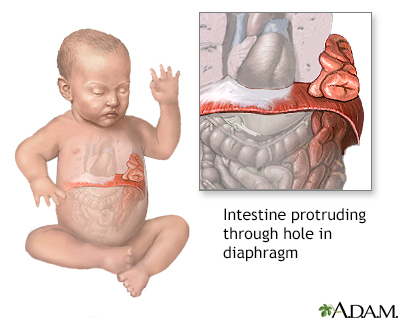Pregnancy SmartSiteTM
Hernia - diaphragmatic; Congenital hernia of the diaphragm (CDH) DefinitionA diaphragmatic hernia is a birth defect in which there is an abnormal opening in the diaphragm. The diaphragm is the muscle between the chest and abdomen that helps you breathe. The abnormal opening allows part of the organs from the belly to move into the chest cavity near the lungs. CausesA diaphragmatic hernia is a rare defect. It occurs while the baby is developing in the womb. The diaphragm is not fully developed. Due to this, organs, such as the stomach, small intestine, spleen, part of the liver, and the kidney may take up part of the chest cavity. CDH most often involves only one side of the diaphragm. It is more common on the left side. Often, the lung tissue and blood vessels in the area do not develop normally either. It is not clear if the diaphragmatic hernia causes the underdeveloped lung tissue and blood vessels, or the other way around. Thirty percent of babies with this condition have other problems as well. Having a parent or sibling with the condition increases the risk. SymptomsSevere breathing problems usually develop shortly after the baby is born. This is due in part to poor movement of the diaphragm muscle and crowding of the lung tissue. Problems with breathing and oxygen levels are often due to underdeveloped lung tissue and blood vessels as well. Other symptoms include:
Exams and TestsFetal ultrasound may show abdominal organs in the chest cavity. The pregnant woman may have a large amount of amniotic fluid. An exam of the infant shows:
A chest x-ray may show abdominal organs in the chest cavity. TreatmentA diaphragmatic hernia repair requires surgery. Surgery is done to place the abdominal organs into the proper position and repair the opening in the diaphragm. The infant will need breathing support during the recovery period. Some infants are placed on a heart/lung bypass machine to help deliver enough oxygen to the body. Outlook (Prognosis)The outcome of surgery depends on how well the baby's lungs have developed. It also depends on whether there are any other congenital problems. Most often the outlook is good for infants who have a sufficient amount of working lung tissue and have no other problems. Medical advances have made it possible for more than one half of infants with this condition to survive. The babies that survive will often have ongoing challenges with breathing, feeding, and growth. Possible ComplicationsComplications may include:
PreventionThere is no known prevention. Couples with a family history of this problem may want to seek genetic counseling. ReferencesAcharya KK, Sprecher AJ, Cohen SS. Diaphragmatic hernia. In: Kliegman RM, St. Geme JW, Blum NJ, et al, eds. Nelson Textbook of Pediatrics. 22nd ed. Philadelphia, PA: Elsevier; 2025:chap 131. Crowley MA. Spectrum of neonatal respiratory disorders. In: Martin RJ, Fanaroff AA, eds. Fanaroff and Martin's Neonatal-Perinatal Medicine. 12th ed. Philadelphia, PA: Elsevier; 2025:chap 67. Harting MT, Hollinger LE, Lally KP. Congenital diaphragmatic hernia and eventration. In: Holcomb GW, Murphy JP, St. Peter SD, eds. Holcomb and Ashcraft's Pediatric Surgery. 7th ed. Philadelphia, PA: Elsevier; 2020:chap 24. Kearney RD. Neonatal resuscitation. In: Walls RM, ed. Rosen's Emergency Medicine: Concepts and Clinical Practice. 10th ed. Philadelphia, PA: Elsevier; 2023:chap 159. | ||
| ||
Review Date: 4/6/2025 Reviewed By: Neil K. Kaneshiro, MD, MHA, Clinical Professor of Pediatrics, University of Washington School of Medicine, Seattle, WA. Also reviewed by David C. Dugdale, MD, Medical Director, Brenda Conaway, Editorial Director, and the A.D.A.M. Editorial team. View References The information provided herein should not be used during any medical emergency or for the diagnosis or treatment of any medical condition. A licensed medical professional should be consulted for diagnosis and treatment of any and all medical conditions. Links to other sites are provided for information only -- they do not constitute endorsements of those other sites. No warranty of any kind, either expressed or implied, is made as to the accuracy, reliability, timeliness, or correctness of any translations made by a third-party service of the information provided herein into any other language. © 1997- A.D.A.M., a business unit of Ebix, Inc. Any duplication or distribution of the information contained herein is strictly prohibited. | ||


 Infant diaphragmat...
Infant diaphragmat...
